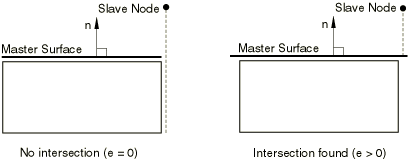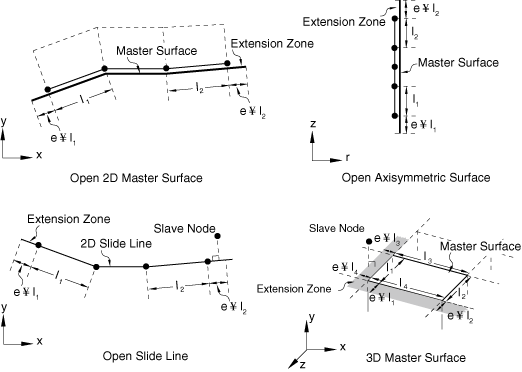Extending master surfaces and slide lines | |||||||||
|
| ||||||||
ProductsAbaqus/Standard
Extending the master surface for small-sliding, node-to-surface contact
If a slave node cannot find an intersection with the master surface at the start of the analysis, it will be free to penetrate the master surface because no local tangent plane will be formed. This type of problem, which typically occurs for node-to-surface contact when the slave node is aligned with the end or perimeter of the master surface (which does not wrap around the corner of the rectangular body), is illustrated in Figure 1 and may be caused by numerical roundoff errors when a preprocessor is used to generate the nodal coordinates. There are no extensions to master faces in the interior of a surface. If the master surface in Figure 1 were defined such that it wrapped around the corner of the body, no extensions to the master surface would be required because the slave node would project onto the master surface using the projection method discussed in Using the small-sliding tracking approach. Cases such as that shown in Figure 1 are not problematic for the small-sliding, surface-to-surface formulation because the constraint formulation considers the region of the slave surface near a slave node.

For node-to-surface contact you can specify the size of the extension zone, e, as a fraction of the end segment or facet edge length (see Figure 2). If e is set to zero, Abaqus will not extend the ends. The value given must lie between 0.0 and 0.2. The default value is 0.1 for node-to-surface contact; surface extensions are not available for surface-to-surface contact.
Input File Usage
CONTACT PAIR, SMALL SLIDING, EXTENSION ZONE=e

![]()
Extending the master surface or slide line in finite-sliding, node-to-surface contact
To prevent slave nodes from “falling off” or getting trapped behind a master surface, an open surface or slide line can be extended beyond its perimeter edges (in three dimensions) or end nodes (in two dimensions) for finite-sliding, node-to-surface contact.
You can specify the size of the extension zone, e, as a fraction of the end segment or facet edge length (see Figure 2). The geometry in the extension zone is extrapolated from the end segment or facet edge. If e is set to zero, Abaqus/Standard will not extend the ends. The value given must lie between 0.0 and 0.2. The default value is 0.1 for node-to-surface contact. Surface extensions are not available for surface-to-surface contact; for finite-sliding, surface-to-surface contact, constraints are located within slave faces, and “falling off” will not occur until nearly the entire slave facet slides off the master surface. Extensions for finite-sliding, node-to-surface contact should be considered only if other modeling techniques to prevent “falling off” are not feasible and when the slave node is expected to travel in the extended zone for a short period of the solution phase or during nonconverged iterations.
Input File Usage
Use either of the following options:
CONTACT PAIR, EXTENSION ZONE=e SLIDE LINE, ELSET=element_set_name, EXTENSION ZONE=e